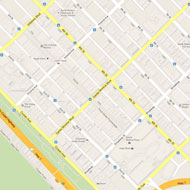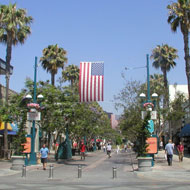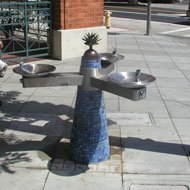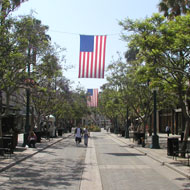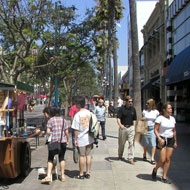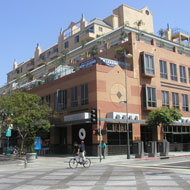Background
The Third Street Promenade is one of the few successful pedestrian malls in USA. This grand mixed-use entertainment venue is about 0.4 miles long. Located in Downtown Santa Monica, the three blocks of the Promenade lie between Broadway and Wilshire Boulevard. Due to its proximity to the Pacific Ocean coupled with Los Angeles's mild climate, it has been a popular tourist destination.
There are more than 60 stores as well as 25 restaurants, cafes and casual dining places on the Promenade. Besides great shopping and dining, the area has many entertainment alternatives, such as movie theaters, venues for performances, clubs and bars.
One of the biggest entertainment attractions of the Third Street Promenade is the eclectic mix of street artists and performers. The Downtown Santa Monica Farmers’ Markets is located at the Promenade on Wednesday and Saturday. There are public parking structures on 2nd and 4th Streets between Wilshire Boulevard and Broadway, and one structure just north of Wilshire on 4th Street.The Third Street Promenade was a typical street with automobile traffic. In1965, the City converted it into a pedestrian mall called the Santa Monica Mall. In 1984, the Santa Monica City Council created a city-funded nonprofit agency called the Third Street Development Corporation, now Downtown Santa Monica, Inc. (DTSM, Inc.), to revitalize the area. With a citywide bond measure issued in 1986, the mall was redesigned and renamed as the Third Street Promenade. A new shopping center, Santa Monica Place, designed by Frank Gehry, was built at the Promenade's southern end. Third Street Promenade opened in 1989, redesigned by the architectural firm ROMA Design Group. The City also created the Third Street Promenade and Downtown District assessment fee. Funded by tenants within the district, it generates approximately $13 million per year for Promenade management.
The Third Street Promenade is an approximately 70-foot wide and lined with trees, shops, kiosks, public art pieces and benches. Shop owners initially felt that preventing cars from accessing their front doors was destroying their business. As a result, the City constructed a road through the Promenade, but placed removable bollards at the ends of each block. Eventually, the street was closed. Now Third Street competes with local shopping centers by providing a festive pedestrian space protected from auto traffic in the heart of downtown Santa Monica, and is a frequent destination for tourists visiting the Los Angeles area (Rawson).
In 2007, the city proposed the Property-Based Assessment District to revitalize the downtown area. It included a wide range of projects, such as enhanced maintenance, new ambassador services, initiatives to reduce homelessness, parking improvements, congestion mitigation, infrastructure updates, marketing, new resource commitments from both the public and private sector, and a new balanced governance structure for Bayside. The old Santa Monica Place, which was a struggling indoor mall, was renovated into an outdoor luxury shopping center by Dallas-based Omniplan. It reopened on August 6, 2010.
Adopted from: Downtown Santa Monica 2008
Lessons Learned
Potential Benefits
- Pedestrian-prioritized street with a great variety of outdoor living rooms and social gathering places.
- A great attraction for people working locally to linger when they want to miss rush hour traffic jams (Moosbrugger 2008).
- Well designed street that maximizes the existing natural context by creating sunny open spaces where people can watch the Pier and feel the ocean breeze.
Potential Issues
- Tourism: The businesses depend on tourism from the outside of the region, which is easily affected by the world economy or high gasoline prices (Moosbrugger 2008).
- Identity: The Promenade have been criticized for loosing its personality by opening homogenized stores and restaurants. However, some feel that the redesigned promenade has created a new identity distinctive to Santa Monica
- Traffic: Neighbors are concerned about traffic congestion along Santa Monica Boulevard, Wilshire Boulevard and Arizona Avenue, and about overcrowded parking structures.
- Local needs: The high-end shops in the renovated Santa Monica Place are also criticized by the locals as not serving the neighbor’s needs(Chang 2010).
Sources
Chang, Andrea, August 7, 2010. “Shoppers Swarm Remodeled Santa Monica Place Mall” Los Angeles Times. (http://articles.latimes.com/2010/aug/07/business/la-fi-santa-monica-place-20100805)
Downtown Santa Monica. “About” (http://www.downtownsm.com/about/index.html)
Downtown Santa Monica. “History” (http://www.downtownsm.com/history/index.html)
Downtown Santa Monica, March 2008. Property-Based Assessment District (PBAD), Summary, Final Plan
Moosbrugger, Ed, February 2008. “Retail Slowdown” from Bay Side Beat. Bayside District Corporation.
Rawson, Kathleen. “Case Study: Third Street Promenade” (http://www.walkinginfo.org/pedsafe/casestudy.cfm?CS_NUM=39)
Photo Sources
MIG, Inc.

